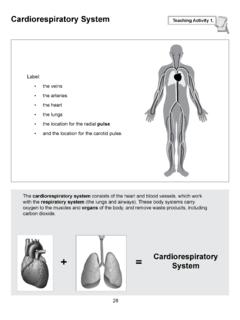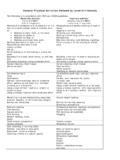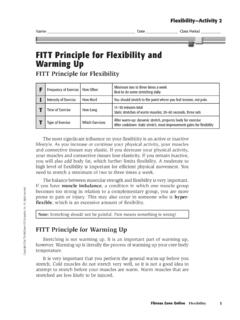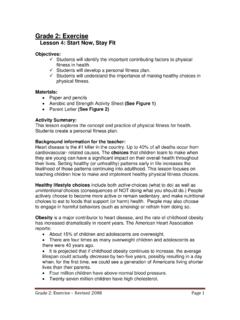Transcription of PHYSICAL EDUCATION - georgiastandards.org
1 PHYSICAL EDUCATION Georgia Standards of Excellence PHYSICAL EDUCATION . Georgia Standards of Excellence (GSE). Kindergarten Grade 5. PHYSICAL EDUCATION Georgia Standards of Excellence Table of Contents Kindergarten PHYSICAL EDUCATION .. 3. First Grade PHYSICAL EDUCATION .. 5. Second Grade PHYSICAL EDUCATION .. 7. Third Grade PHYSICAL EDUCATION .. 9. Fourth Grade PHYSICAL EDUCATION .. 12. Fifth Grade PHYSICAL EDUCATION .. 15. Georgia Department of EDUCATION May 3, 2018 Page 2 of 16. PHYSICAL EDUCATION Georgia Standards of Excellence Kindergarten PHYSICAL EDUCATION Course Description: This course will introduce students to locomotor and non-locomotor skills. Students will explore manipulative skills using a variety of equipment ( , balls, scarves, and bean bags).
2 Students will participate in basic PHYSICAL fitness activities. Students will become familiarized with rules, safety, and etiquette as it applies to self and others within a PHYSICAL EDUCATION setting. The physically educated student has developmentally appropriate grade-level comprehension and application of the concepts and principles of fitness, motor skills, movement patterns, tactics, and strategies which contribute to a physically literate and active lifestyle. Motor Skills and Movement Patterns The physically educated student demonstrates competency in a variety of motor skills and movement patterns. Locomotor a. Performs basic locomotor skills (walk, run, hop, jump, skip, slide, and gallop) while maintaining balance. b. Performs locomotor skills in response to teacher-led, creative dance.
3 C. Performs jumping/landing with balance. Non-Locomotor d. Performs basic non-locomotor skills (bend, straighten, twist, stretch, swing, sway, and turn) while maintaining balance. e. Maintains balance on different bases of support (wide, narrow, curled, and twisted body shapes). Manipulative Skills f. Throws underhand with opposite foot forward. g. Catches a self-tossed object (ball, scarf, and bean bag). h. Drops a ball and catches it after a single bounce. i. Demonstrates basic dribbling skills with hands attempting multiple contacts. j. Demonstrates basic dribbling skills with feet attempting multiple contacts. k. Kicks a stationary ball from a stationary position (keeping eyes on the ball, stepping with the opposite foot next to ball, contacting the ball with dominant foot, and following through).
4 L. Volleys a lightweight object (beach ball or balloon) upward using a variety of body parts. m. Strikes a lightweight object (beach ball or balloon) using a short-handled implement. n. Executes a single jump using a self-turned rope. o. Executes a single jump of a long rope with teacher assisted turning. Georgia Department of EDUCATION May 3, 2018 Page 3 of 16. PHYSICAL EDUCATION Georgia Standards of Excellence Movement Concepts and Principles The physically educated student applies the knowledge of concepts, principles, strategies, and tactics related to movement and performance. a. Demonstrates an understanding of general and personal space by traveling without bumping into another student. b. Performs a rhythmic activity in a personal space.
5 C. Travels in three different pathways (straight, curved, and zig zag). d. Travels in general space with different speeds. e. Travels in general space on different levels. Fitness The physically educated student demonstrates knowledge and skills to help achieve and maintain a health-enhancing level of PHYSICAL activity and fitness. a. Identifies active play opportunities outside the PHYSICAL EDUCATION setting. b. Actively participates in PHYSICAL EDUCATION class. c. Recognizes that moving at a fast pace increases heart rate and breathing. Personal and Social Behavior, Rules, Safety, and Etiquette The physically educated student exhibits responsible personal and social behavior that respects self and others in PHYSICAL activity settings. a. Follows directions individually and in a group setting (follows rules and takes turns).
6 B. Acknowledges responsibility for behavior when prompted. c. Shares equipment and space with others. d. Recognizes the established classroom procedures. e. Follows teacher directions for safe participation and proper use of equipment with minimal reminders. The physically educated student recognizes the value of PHYSICAL activity for health, enjoyment, challenge, self-expression, and/or social interaction. a. Recognizes that PHYSICAL activity is important for good health. b. Acknowledges that some PHYSICAL activities are challenging/difficult. c. Identifies PHYSICAL activities that are enjoyable. d. Recognizes the enjoyment of playing with others. e. Accepts and respects differences and similarities of PHYSICAL abilities in self and others. Georgia Department of EDUCATION May 3, 2018 Page 4 of 16.
7 PHYSICAL EDUCATION Georgia Standards of Excellence First Grade PHYSICAL EDUCATION Course Description: This course will include participating in locomotor skills (dance, game, or combination with non-locomotor skills) that demonstrate mature form in the hop, jump, and leap skills. Students will demonstrate the ability to move in a variety of pathways, in different directions, and at different levels in personal and general space. Several non-locomotor skills will be utilized in a sequence or in conjunction with locomotor or manipulative skills. Students will demonstrate the ability to direct manipulative objects toward an intended target. The physically educated student has developmentally appropriate grade-level comprehension and application of the concepts and principles of fitness, motor skills, movement patterns, tactics, and strategies which contribute to a physically literate and active lifestyle.
8 Motor Skills and Movement Patterns The physically educated student demonstrates competency in a variety of motor skills and movement patterns. Locomotor a. Performs hops, gallops, jogs, and slides using a mature form. b. Performs mature pattern of jumping in a horizontal and vertical plane. c. Performs non-locomotor and locomotor combinations. Non-Locomotor d. Performs mature form of landing in a horizontal and vertical plane. e. Maintains balance on different bases of support while maintaining different body shapes. f. Transfers weight from one body part to another maintaining personal space. g. Rolls with either a narrow or curled body shape. h. Demonstrates twisting, curling, bending, and stretching actions. Manipulative Skills i. Demonstrates underhand throwing techniques following teacher cues.
9 J. Catches various sized objects. k. Dribbles continuously in personal space using the dominant hand. l. Dribbles a ball using the inside of the foot while walking in general space. m. Approaches a stationary ball and kicks it forward while refining correct kicking form (keeping eye on the ball, walking up to the ball, stepping with opposite foot next to ball, contacting the ball with dominant foot, and following through). n. Volleys an object upward with an open hand. o. Strikes an object with a short-handled implement using a proper grip. p. Jumps forward or backward consecutively using a self-turned rope. q. Jumps a long rope consecutively with teacher assisted turning. Georgia Department of EDUCATION May 3, 2018 Page 5 of 16. PHYSICAL EDUCATION Georgia Standards of Excellence Movement Concepts and Principles The physically educated student applies the knowledge of concepts, principles, strategies, and tactics related to movement and performance.
10 A. Responds to different beats/rhythms in personal and general space. b. Travels demonstrating low, medium, and high levels. c. Travels over, under, around, and through a variety of objects. d. Differentiates between fast and slow speeds. e. Differentiates between strong and light force. Fitness The physically educated student demonstrates knowledge and skills to help achieve and maintain a health-enhancing level of PHYSICAL activity and fitness. a. Discusses the benefits of exercising/playing and being active. b. Actively engages in PHYSICAL EDUCATION class. c. Identifies the heart as a muscle that grows stronger with exercise, play, and PHYSICAL activity. d. Practices the proper protocol for each Georgia Fitness Assessment component. Personal and Social Behavior, Rules, Safety, and Etiquette The physically educated student exhibits responsible personal and social behavior that respects self and others in PHYSICAL activity settings.

















